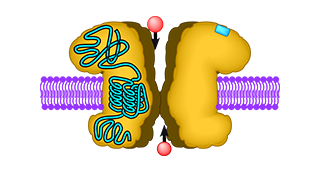Publication of the Year 2017
D. Tapken, T.B. Steffensen, R. Leth, L.B. Kristensen, A. Gerbola, M. Gajhede, F.S. Jørgensen, L. Olsen, and J.S. Kastrup (2017).
The low binding affinity of D-serine at the ionotropic glutamate receptor GluD2 can be attributed to the hinge region.
Scientific Reports 7: 46145.
doi: 10.1038/srep46145
Abstract
 Ionotropic glutamate receptors (iGluRs) are ion channels that mediate most of the excitatory signalling in the brain. They are generally activated by the neurotransmitter glutamate, with some additionally requiring glycine or D-serine as a co-agonist that binds to specific subunits. Activation leads to opening of the ion channel, allowing influx of mainly Na+, in some cases also Ca2+ ions. However, one member of the iGluR family, GluD2, has not yet been shown to be activated by any ligand, although it binds glycine and D-serine with low affinity. Using oocyte electrophysiology, isothermal titration calorimetry and molecular dynamics simulations on GluD2 mutants, we investigated why GluD2 binds D-serine with such a low affinity compared to other iGluR subunits. We found that the region of the ligand-binding domain serving as a hinge for the conformational change induced by D-serine binding is responsible for the low affinity. Mutating this hinge to that of the high-affinity D-serine-binding subunit GluN1 strongly increases D-serine affinity of GluD2.
Ionotropic glutamate receptors (iGluRs) are ion channels that mediate most of the excitatory signalling in the brain. They are generally activated by the neurotransmitter glutamate, with some additionally requiring glycine or D-serine as a co-agonist that binds to specific subunits. Activation leads to opening of the ion channel, allowing influx of mainly Na+, in some cases also Ca2+ ions. However, one member of the iGluR family, GluD2, has not yet been shown to be activated by any ligand, although it binds glycine and D-serine with low affinity. Using oocyte electrophysiology, isothermal titration calorimetry and molecular dynamics simulations on GluD2 mutants, we investigated why GluD2 binds D-serine with such a low affinity compared to other iGluR subunits. We found that the region of the ligand-binding domain serving as a hinge for the conformational change induced by D-serine binding is responsible for the low affinity. Mutating this hinge to that of the high-affinity D-serine-binding subunit GluN1 strongly increases D-serine affinity of GluD2.



